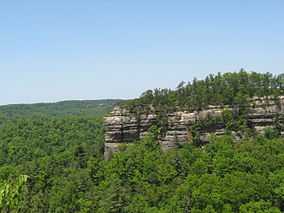Red River Gorge
| Red River Gorge Geological Area | |
|---|---|

Chimney Top Rock
|
|
| Location of Red River Gorge in Kentucky | |
| Location | Slade, Kentucky, United States |
| Coordinates | 37°50′2″N 83°36′28″W / 37.83389°N 83.60778°WCoordinates: 37°50′2″N 83°36′28″W / 37.83389°N 83.60778°W |
| Area | 29,000 acres (120 km2) |
| Established | February 1937 |
| Governing body | United States Forest Service |
| http://www.fs.usda.gov/detail/dbnf/specialplaces/?cid=stelprdb5345319 | |
| Designated | 1975 |
The Red River Gorge is a canyon system on the Red River in east-central Kentucky. Geologically, it is part of the Pottsville Escarpment.
Much of the Gorge is located inside the Daniel Boone National Forest and has been subsequently reserved as the Red River Gorge Geological Area, an area of around 29,000 acres (120 km2; 45 sq mi). It has been designated a National Natural Landmark and National Archaeological District, and it is listed on the National Register of Historic Places. The 13,379-acre (54.14 km2; 20.905 sq mi) Clifty Wilderness Area lies entirely within the geological area in the Red River Gorge.
This intricate canyon system features an abundance of high sandstone cliffs, rock shelters, waterfalls, and natural bridges. There are more than 100 natural sandstone arches in the Red River Gorge Geological Area. The multitude of sandstone and cliff-lines have helped this area become one of the world's top rock climbing destinations and is home to the Red River Gorge Climbers' Coalition. The area is nicknamed the Red by climbers.
Kentucky's Natural Bridge State Park is immediately adjacent to this area, featuring one of the largest natural bridges in the Red River Gorge.
Because of its unusual and rugged nature, the Red River Gorge features a remarkable variety of ecological zones.
Nada Tunnel is a 900-foot-long (270 m), 12-foot-wide (3.7 m), and 13-foot-high (4.0 m) logging tunnel built between 1910 and 1912. Rock and dirt were removed by dynamite, steam drills, and hand tools. One man was killed during tunnel construction when he attempted to thaw frozen dynamite which exploded when he set it near a fire.
...
Wikipedia

